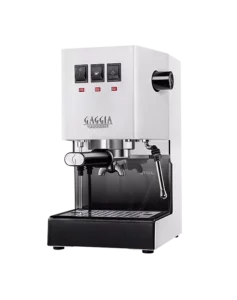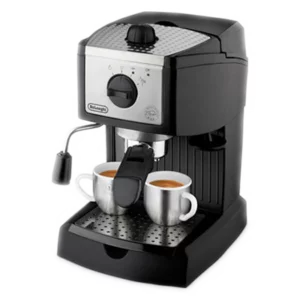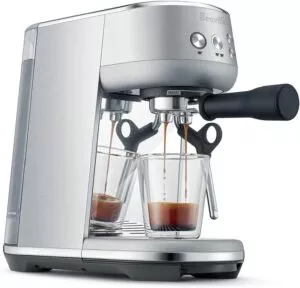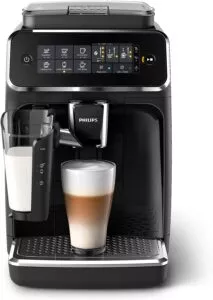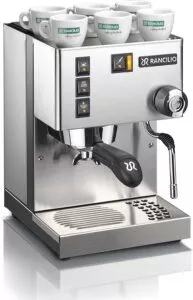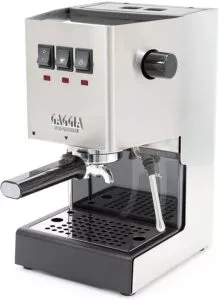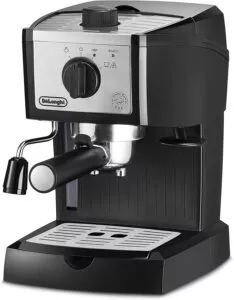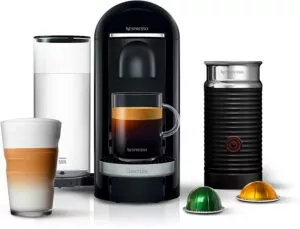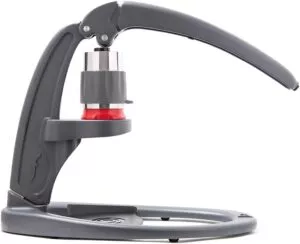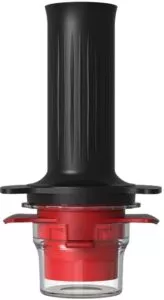
Best Espresso Machine to Start Your Day Right
Canadians love their coffee. While many go for the classic drip coffee, the allure of espresso has attracted many to its dark ways. Strong, bold, and highly caffeinated, espresso can be enjoyed many forms: fluffy cappuccinos, smooth americanos, an after-dinner accompaniment straight up (or with a dash of sugar). All of these are great ways to enjoy this highly versatile drink.
However, if you are in the market for an Espresso machine, it can get overwhelming fast. Espresso can range from a quick jolt of morning energy to a hobby that requires dedication and practice in search of the perfect shot, to anywhere in between. Since espresso machines usually can cost a chunk of change, ensuring you have the right machine for your purposes is an important endeavor. That is why we made this buying guide of the best espresso machines of 2024.
Our top picks
List of best espresso machines in 2024
- Best home espresso machine –Rancilio Silvia
- Best semi automatic espresso machine – Gaggia Classic Pro (Top Pick)
- Best small espresso machine – Breville Bambino Pro (Top Pick)
- Best budget espresso machine – DeLonghi EC155 (Top Pick)
- Best Nespresso machine – Breville VertuoPlus
- Best automatic espresso machine – Philips 3200 LatteGo (Top Pick)
- Best manual espresso machine – Flair NEO
- Best portable espresso machine – Cafflano KOMPRESSO Espresso Maker
What type of espresso machine is right for you?
What type of Espresso machine you might be looking at is the first thing you should consider. There are roughly 4 or 5 categories of Espresso machine, depending on who you ask.
Manual machines are the simplest machine of the bunch in terms of components but are hardest to master, as they require you to pull a lever to extract hot water through finely ground beans.
Automatic machines feature water heaters and will pump hot water though the ground coffee, with aspects like time and water flow automated but programmable. These machines are the simplest to use since it removes human controlled variables, but also this limits the ability to finely tune the espresso to your liking.
Super-automatic machines take it a step further, and can make entire drinks like Lattes and Americanos with just the touch of a button.
Semi-automatic machines feature a hot water heater and similarly pump water through the machines, but allow the user more control, letting you pull your shot as long as you want.
Capsule machines are by far the easiest and fastest to use, using compatible pods or capsules to brew espresso. While these machines are super easy to use, it removes user control from the equation completely, and the environmental impact with some pods is concerning.
What to look for in an espresso machine
After you decide on which type of espresso machine suits your purposes best, you can then start to think about the following aspects.
Feature set: Anything beyond a machine’s ability to produce espresso can contribute to this factor. A very common feature that many machines feature is a milk frother, giving the user an ability to make cappuccinos and lattes very easily. However, bonus features can range from automatic timers that you can set for the time you wake up, to built in coffee grinders, to a whole range of other options.
Maintenance: You are going to need to clean your espresso machine every so often, depending on how frequently you use it. We considered how easy it is to take apart components, like the group head where the water comes out, or how easy the water reservoir can come off if limescale builds up. We also looked at if the machine allows for backflushing, which can help clean the internal workings of the machine. Ultimately, we understand that a finicky cleaning process can be a big headache, and for some users, a dealbreaker.
Portafilter & Basket: So, some of you might be wondering what these words mean. The portafilter is the cup-like attachment with a long handle that twists onto the espresso machine. Inside of it sits the basket, which acts like a filter. There are two types of baskets when it comes to making coffee: pressurized and non-pressurized. Pressurized baskets have a tiny hole at the bottom, where non-pressurized have many holes. Pressurized baskets encourage the development of a crema with older beans, or beans that are not quite ground to the right size, and often used in cheaper machines. They definitely have their place for people who are not espresso hobbyists. However, if you grind your own beans, the fine grind that is ideal from a quality burr grinder can clog these units up. Non-pressurized baskets work better with fresh, fine ground beans and are typically preferred by espresso enthusiasts. If a model has one type of basket and you prefer another, it usually is not hard to replace the basket. However, finding the right basket usually depends on the size of the portafilter, which 58mm is the standard size.
Pressure: Pressure is a very important aspect in terms of quality espresso. Some brands advertise higher pressures into the 15-bar range – and I think this is to confuse users who are not sure what they are looking for and assume bigger means better. In our research, we found that the commonly agreed upon sweet spot is around 9 bars of pressure. This can range for different types of espresso, like pre-ground or capsule espresso, but overall being able to control pressure is commonly seen more on expensive machines.
Temperature: Espresso should be brewed between 90-96 degrees Celsius, for ideal tasting coffee. Hotter temperatures can result in overextraction or potentially burnt coffee and can result in a harsh pour. Colder and you will get a weak, acidic espresso that is associated with under-extracted coffee. We looked at the temperature range each machine uses. Some machines run hot and require you to “surf” the temperature, running the machine while the water inside starts to cool down to a more appropriate level. While this might be frustrating at first, many of the machines that run hot can easily be temperature surfed if you wait a specific time, like 30 seconds after the machine has done heating the water.
Best home espresso machine
Rancilio Silvia
If you are serious about your espresso and want something in the “prosumer” category – a borderline café-quality espresso machine for your home – the Rancilio Silvia is a very popular choice in the espresso community. This manual espresso machine makes great shots and can last you decades if you treat it right.
With a rectangular, stainless steel body that looks like a countertop sized version of what you would see in a coffee house, the Rancilio Silvia screams that it is a serious espresso machine. This machine has heft, so once you find a place for it on your countertop, it is not moving – so you do not need to bearhug this machine to twist the portafilter on. With an ergonomic 58mm portafilter with two non-pressurized filter baskets (for single and double shots) and double spout for pouring one or two shots at once, the Rancilio Silvia is designed for impressively authentic espresso. The flat top is a perfect place for storing espresso cups, warming them in the process. The water tank and drip tray do not have clear indicators of their volume, so knowing if you have enough water or if you are about to overflow requires taking the steps to check.
In terms of making espresso, the Rancilio machine is a solid machine overall, that might need some learning or work to figure out how to get the most out of it. One of the drawbacks is that the machine runs a little hot, and likely you might see steam when making an espresso, indicating water hotter than the 90-96 degree Celsius sweet spot. Some users remedy this by “temperature surfing,” as the internet’s resident coffee expert James Hoffmann puts it, where you let the machine run hot water through the machine and extract your espresso after the initial run as the machine is heating back up. Some users have looked to modding this unit, and there is a community of users online who look to mod this machine for better results, who have resources available. These mods can help improve the brew temperature but can cost more on top of the already significant price tag. The other alternative is opting for the Rancilio Silvia PID, which is a factory-built version which brings in a Proportional Integral Derivative unit for better temperature control. This will also up the price but is worth it if you are uncertain about completing the mods yourself.
The Silvia boasts a very impressive, café quality steam wand that steam wands that produces excellent frothy milk if you know what you are doing – but if you do not, or are just trying to figure out milk frothing, it can be daunting due to the technique it requires. The Rancilio Silvia overall is a machine worthwhile upgrading if you develop a strong passion for pouring espresso and making milk drinks, however the learning curve makes it less ideal for your first espresso machine.
Cleaning this machine is not hard, but it is highly recommended you do it thoroughly, backflushing the machine regularly, and de-scaling when necessary. Users are overall are impressed with the quality of espresso and the quality of the unit itself. While the temperature fluctuations might result in inconsistent brews, this issue can be navigated around, and the espresso is still worth the money. The Rancilio Silvia is a costly unit (although similar espresso machines can run significantly higher) but very worthwhile as an upgrade pick if you get the espresso itch.
Pros
- Sturdy, stainless steel body, with a strong, durable, design that looks like it belongs in a coffee house.
- Includes double, unpressurized baskets for a 58mm portafilter.
- Excellent, café quality steam wand for optimal milk frothing, if you know what you are doing.
Cons
- Base machine runs on the hot side, which can be difficult to work around.
- Learning curve involved make this machine less ideal for newer users.
Best semi automatic espresso machine
Gaggia Classic Pro
The Gaggia Classic Pro is a very popular model of espresso machine renown on coffee forums everywhere. From espresso enthusiasts to beginners, users found that machine can make excellent espressos.
With a large, stainless steel body, the Gaggia Classic Pro looks like a solid espresso machine while also not being intimidating. The Gaggia Classic Pro has a 58mm portafilter, with dual spouts so you can pour two shots at a time. The water reservoir is also solidly big at 71 oz, and accessible from the front (once the drip tray is removed) but you can also pour water into the reservoir though the top of the unit. The drip tray is large but does not have a float to see how much room is in the drip tray. One thing that is frustrating with the Classic Pro is the spout does not sit too far above the drip tray, which does not give enough height for users who want to put a scale underneath their espresso/cappuccino cup for precise measurements. The Gaggia’s steam wand does seem to be lacking in pressure and power and is overall less ideal for milk drinks but is still usable.
The Gaggia Classic Pro comes with both a pressurized and non-pressurized basket for the portafilter, so you can either go with pre-ground coffee in the pressurized or grind your own with the commercial basket. The Gaggia Classic Pro has a 3-way solenoid valve, also commonly found in commercial machines, which relieves pressure in the brewing chamber and for an easily removable puck and the ability to make back-to-back espresso very easily. One thing that the Gaggia has is a higher pressure of around 15-bar, which can lead to a certain harshness to your espresso for discerning drinkers who want to grind their own beans. There is a solution to the high pressure, that involves modifying the unit, which will not be too hard, but you will likely void your warranty in the process. The Gaggia is a favourite for modders, as the weaknesses of this machine – temperature and pressure – can be adjusted and the resulting machine when modded properly can be a huge boost to the Gaggia Classic Pro. There is a large community of Gaggia Classic owners that share their knowledge on modding online if you are interested in improving these results.
Overall, if you are looking to make espresso a hobby, many enthusiasts will point you in the direction of the Gaggia Classic. This machine has a lot of solid qualities to it, its flaws can be remedied, and is not too steep of a price for an espresso machine that can contend with much more expensive models.
Pros
- Comes with a standard sized portafilter with both pressurized and non-pressurized baskets.
- Includes Solenoid valve for easier cleaning of the machine.
- Largest water tank on this list.
Cons
- The pressure is above the ideal internal pressure for brewing fresh ground espresso, but this can be remedied.
- Below average milk steam wand.
Best small espresso
Breville Bambino Plus
If you are looking for an easy-to-use automatic espresso machine that can make impressive drinks, without getting too into the coffee-enthusiast side of espresso machines, the Breville Bambino Plus is a great place to start. The Bambino Plus has many impressive features, in both manual to automatic functionality, including a solid milk steamer and 3 second heat up time.
The Bambino Plus is a smaller, elegant looking machine that will not take up much counterspace. While it is primarily plastic, the machine has a silver aesthetic that would suit most spaces. There is a nice distance from underneath where the portafilter sits to the drip tray, so this lets users who are interested in learning how to make quality espresso put a coffee scale underneath their cup. While the drip tray is not very large, it does have a float to indicate when it needs emptying.
While some espresso machines take significant time in terms of heating up, the Bambino Plus heats up in an impressive 3 seconds. This in conjunction with the digital temperature control via PID allows for optimal extraction of your espresso. The Bambino Plus also features low-pressure pre-infusion, where the ground espresso is moistened with water at low pressure before hot water is pumped through it. This technique is proven to improve even extraction, as water will disperse evenly through the espresso and reduce channelling (where the water pushes the coffee out of the way in the brew chamber). The Bambino Plus features a 15-bar pump, that is set to deliver that ideal 9-bars of pressure. The Bambino Plus features a 54 mm portafilter ideal for 19 grams of espresso. This unit comes stock with a pressurized, double-wall backet, but you can order a single wall basket if you are looking to improving this aspect of your espresso machine.
One of the features of the Bambino Plus where it excels is the milk steaming. Manually, the milk steamer is powerful, but gives you enough time to develop foam, resulting in quality steamed milk, perfect for lattes. But not everyone will care to do it manually when a unit like this features a well-equipped automated milk steaming feature, which allows you to pick your temperature and texture. Either way, this unit features one of the easiest to use milk steamers among household espresso machines. Another thing we can rave about with this machine: the steam wand is self cleaning (just make sure the wand is pointing at the drip tray, unless you do not mind cleaning up after it).
There are some common criticisms on this machine that may influence your decision on purchasing this unit. Since this unit is small or lightweight, some users have complained about twisting the portafilter onto the group, feeling they need to bearhug the machine to get a secure enough seal. Apparently for some users, with time this gets easier. Some users took issue with the drip tray being shallow. Overall, users find this machine in a sweet spot in between ease-of-use and delicious espresso beverages. If you do not want to adjust settings and pour times and still have good espresso, the Bambino plus is a great pick. Looking to save a little more? The base Bambino lacks the auto-frothing capabilities at a cheaper price.
Pros
- TurboJet technology heats water as fast as 3 seconds, with PID for optimal temperature control.
- This espresso machine features optimal pressure, with bonus features like pre-infusion included.
- Great steam wand with both manual and automatic functionality.
Cons
- 54 mm portafilter that only comes with a pressurized basket, and unpressurized baskets of this size are expensive.
- Some users had issues twisting the portafilter on the group head, due to overall lightness of the machine.
- Small drip tray.
Best budget espresso machine
DeLonghi EC155M
Espresso machines can be very expensive, but they do not have to be. The De’Longhi EC155M is an excellent beginner machine due to its lower price and easiness to use, but it can be further modified for improved results if you get the itch for better espresso.
The EC155M is a more compact machine, that will sit on your countertop without taking up too much real estate. It may not impress your friends with its chrome on black aesthetic, but at this price, it does not need to. The distance from the portafilter to drip tray is only big enough for espresso cups, and if you want to weigh your shot, you might struggle to fit in this tight squeeze. The drip tray for this machine is easily removable and machine washable. One thing not very popular among users is the location of the tamper, which is fixed to the right of where the portafilter sits and requires an awkward pushing-up motion to tamp the coffee.
The De’Longhi is a simple manual espresso machine that is great for beginners due to its feature set but can be upgraded if your taste changes. The model features a 52mm portafilter with a pressurized basket, which makes sense for a machine on the lower side of the price spectrum, as these specs are suited for getting crema and texture for pre-ground or imperfectly ground beans. The three-in-one portafilter has baskets for single and double espresso shots, and one for an easy-serve espresso (ESE) pods, which are gaining more traction. Many swear by self-ground beans, so you will either need to buy a non-pressurized basket or make some slight modifications if you want to grind your own espresso for the EC155M. With two internal thermometers, the Rapid Cappuccino System maintains the temperature of the machine at optimal rates, so you can brew drinks for the family or any guests you may have. The De’Longhi EC155M is advertised having 15-bars of pressure, which is above what is ideal, but with a budget espresso machine, there are going to be things you will have to sacrifice.
The De’Longhi EC155M features an entirely removable 35 oz water tank, which is on the smaller side of some of the tanks of machines listed on this list. The controls for this unit are minimal: a 4-mode dial that has features for (from left to right) getting steam temperature, off, on, and to pour espresso, and a knob on top can be used to control the steam wand or to even expense hot water. Like most espresso machines, the De’Longhi features a milk steamer for making milk drinks like cappuccinos or lattes. While users have stated the milk steamer is not great, it is serviceable, and is one such aspect that users have had luck modding themselves.
Users overall are satisfied with this machine. Many users who want espresso occasionally can enjoy this machine’s ease of use and its price tag. For espresso enthusiasts, this is one of the better machines at its price range and is relatively easily modded. While it will not compete with the more expensive models, it is perfectly serviceable. However, you do notice the corners that have been cut – like build quality for one.
Pros
- Inexpensive option that can still produce quality espresso, if you add the right components or modify certain aspects, like the portafilter.
- Small footprint can fit on any countertop.
- Fast heating so you can enjoy your espresso quickly.
Cons
- Users have noted this machine vibrates a lot when in use, and that this can rattle and be noisy.
- Low portafilter and group head mean you are limited to certain cups when brewing.
- Awkward tamper comes fixed onto the machine.
Best pod espresso machine
Breville Nespresso Vertuo
This article spends a significant amount of time zeroed in espresso machines that can be chosen for making quality shots of espresso, but what if you are always on the rush? Many offices run on coffee (ours included), and the Nespresso Vertuo line is great for taking care of your office’s espresso and coffee needs.
This Breville Nespresso machine is a comprised mostly of black plastic and is the perfect size for countertop or desk space. The machine features a removable 40-oz water tank, which for pod machines is a decent size.
The Breville Vertuo machine is compatible with Nestle’ Nespresso line of Espresso pods. For many, these pods are one of the easiest ways to get espresso, and while pods are inherently wasteful, Nespresso has a commited recycling program for their pods which makes enjoying espresso while being environmentally conscious easy. Nespresso pods utilize Nespresso’s patented Centrifusion process to improve extraction, spinning up to 7,000 times per minute. The result is a rich, hot cup of either coffee or espresso with a gorgeous crema. What is better is that this Vertuo machine uses an intelligent extraction system that reads a barcode on each capsule and uses that barcode to determine the exact steps required for the optimal brew. Brewing with this unit is so easy, it literally only requires the touch of a button. Many of these features can be seen in most Nespresso Vertuo machines, so you cannot go wrong with most available Vertuo machines.
This Breville Vertuo unit includes the Aeroccino Plus – a simple, automatic milk frother without noise or vibration. This makes the Nespresso one of the simplest ways of making tasty milk drinks. Also included with this unit is 12 different Vertuoline capsules, with varying strength and flavours so you can pick your favourites.
Overall, if your main objective in owning an espresso machine is having a variety of coffees at your fingertips, this Breville Nespresso Vertuo machine is a great pick. However, what you get is what you get with machines like this. You cannot make adjustments to temperature, and some users find their coffee cold once it is dispensed. You are also locked into Nespresso Vertuo coffee and 3rd party pods, and the coffee itself, depending on your taste, is palatable and easy drinking, but does not wow. I have sipped on a selection of Vertuo coffees while writing this article and generally found them mostly low on the flavour chart. However, comparatively to other pod coffee machines, Nespresso stands above the others handily.
Pros
- Easy coffee or espresso, only needing a press of a button to start.
- Includes the Aeroccino, a supremely easy milk frother, for free.
- Committed recycling program means that you can enjoy your coffee without worrying too much about excess waste.
Cons
- You have no control over the brewing process, since everything is automatic.
- Some users reported the coffee came out was a subpar temperature.
Best automatic espresso machine
Philips 3200 LatteGo
Automatic or super automatic coffee machines are for ideal for people who want the full barista experience without the hassle, or the expertise required. The Philips 3200 LatteGo is one of the latter machines that can quickly and easily deal with any of your coffee needs, from espresso shots to frothy cappuccinos to your regular cup of coffee, without the hassle required.
The Philips LatteGo is a sleek machine composed mostly of black plastic, with chrome accents. With its smaller footprint, the 3200 LatteGo is best suited on the countertop. Looking at the machine, you might notice many features unlike other espresso machines featured on this list. There is a reservoir on the front for milk for frothing, there is a compartment on the top for storing and grinding whole coffee beans. But the most stand out aspect visually is the large control panel with several presets for some of the most popular espresso and coffee drinks, as well as controls for aroma strength, coffee quantity, and the milk froth.
So, what can this unit do? As mentioned previously, this unit has a compartment for storing beans, which it can grind automatically whenever you start making a coffee – or you can also use pre-ground coffee, which can be loaded into a slot inside the compartment. There is a 12-step grinder control inside, allowing you to control the grind size of the automatic grinder. The automatic milk frother makes milk perfect for drink cappuccino and lattes alike, without the technique necessary for making milk with a steam wand. There is a large, 60 oz water reservoir, and an included AquaClean filter to ensure your coffee is not impeded by water impurities and allows you to make up to 5,000 coffees without needing to descale the machine. This means that every aspect of your morning coffee can be automated.
Users like the simplicity of this machine, from its ergonomic design to its automatic preparation of whatever coffee drink you might want at a time. However, with any automatic machine, you are relinquishing control for convenience. This can be an issue with so many different components, so inconsistency is common. Some users were very critical of the espresso this machine produces, one user stating the espresso was watery, lukewarm, and lacking a nice crema. Some users were frustrated with the lack of customization of the beverages – the double version of each drink does not allow for customization of the drink volume, and you cannot froth milk without running the cappuccino or latte modes, for examples. Cleaning is not hard – many of the components are dishwasher safe, and the internal espresso brewing group are easily washable and only needs to be washed once a week. With so many different parts, in a hot, wet enclosed environment, there are many ways this machine could fail, and servicing of this machine can be difficult. Overall, if you want to make espresso drinks quickly and easily each morning, the Philips 3200 LattePro is a great selection. However, discerning espresso enthusiasts might want a little bit more control from their espresso machine.
Pros
- Make a wide selection of drinks just by programming your preferences.
- Built-in coffee grinder and milk frother make this an all-in-one unit.
- Large water reservoir with included filter to purify water and reduce the need to descale.
Cons
- Users experienced inconsistency and sometimes subpar espresso shots.
- Some control options are short sighted and rigid, including needing to run the cappuccino or latte modes for steaming milk.
Best manual espresso machine
Flair NEO
Manual espresso machines are not as simple as they seem. While there are no high-tech parts, there is an extra skillset when it comes to pulling espresso – which we mean literally. If you are looking for a strong manual espresso machine, the NEO by Flair Espresso is a very notable model. Not only is it a solidly priced manual espresso machine (compared to other favourites like the Cafelat Robot), but the modular design that allows for upgrades along your espresso journey.
The Flair NEO looks quite unlike other espresso machines on this list. Instead of a blocky machine, the NEO features a simple skeleton, with a three-part brewing mechanism and an arm for applying pressure. For brewing, there are three simple components: a flow controlled pressurized portafilter that allows a dose between 12 and 18 grams of espresso, a 60 ml water reservoir, and a plunger component that when you push down the arm, creates a seal to build the pressure ideal for a great shot of espresso. The result is up to 45 ml of delicious espresso with a nice crema, with the satisfaction you did it all by hand.
While the pressurized portafilter is great for courser or uneven ground coffee, but not ideal for if you want to grind your own beans, as the finer ground might plug the singular hole. However, the modular aspect of the Flair NEO includes a 2-in-1 portafilter with a non-pressurized filter. There is also a pressure gauge that allows you to get the appropriate pressure ideal for delicious pressure – between 6 to 10 bars. The modular aspect of this unit allows you to build the espresso maker you desire or allows you to defer part of the price of a full developed manual espresso maker for later. Both add-ons are easily available on Flair’s website.
Users find this machine surprisingly easy to use, although a little tedious if required to pull multiple shots. One complaint we saw that was common was that the portafilter included can get clogged easily, which can cause it to break if too much pressure is exerted. Most users have stated that they shortly after bought the 2-in-1 portafilter attachment for even better tasting espresso. With a manual espresso maker, there is an entirely different set of challenges you will face than other espresso machines. One thing you might look to invest in is a kettle with precise temperature controls since this is a variable you will want to control as much as possible with manual espresso pours.
Pros
- Modular system allows for you to make upgrades to your NEO as you see fit.
- Impressive tasting espresso with a crema comparable to high profile espresso machines.
- If you can find a good deal, this can be a much more cost-effective part of your espresso set up.
Cons
- Stock portafilter leaves something to be desired in terms of brew and durability.
- There is a learning curve specific to manual espresso machines that might not attract all users.
- Not ideal for making espresso for a group of people.
Best portable espresso maker
Cafflano KOMPRESSO Espresso Maker
Many Espresso makers require time, space, preparation, and so it may seem espresso away from home might be a no-go. Enter the Cafflano Kompresso espresso maker. This handheld coffee maker can be a great way to enjoy an espresso-like drink wherever you want to go.
The Cafflano Kompresso is a small, handheld device that can easily fit into a backpack or a purse. The Kompresso features 5 components: a narrow chamber, a piston, a filter basket with a non-pressurized filter, a tamping scoop and a small cup. The filter basket features a capacity of 15g of ground coffee, and the chamber can hold up to 70ml of water. All the components easily fit together, and do not require anything else – other than coffee and hot water. Altogether, this unit weighs less than 200g, and is approximately 17 cm in length.
Similar to other hand pump coffee makers, the Cafflano Kompresso uses hydraulic water compression instead of pneumatic air compression to apply pressure for the brewing process. While Cafflano states that the Kompresso can generate that ideal 9 bars for brewing espresso, the science behind the Kompressor requires between 30 to 54 kg of force on the Kompressor, which is a significant amount of force still, but doable for some. The resulting drink ranges from “espresso-like” strong shots of coffee, to full on espresso with a delectable crema, depending on the force applied.
Overall, users find that this unit makes a solid shot of espresso or strong coffee on the go. Users have found that it requires some fine tuning to get strong results: you likely need very fine ground coffee and a scale to get the best tasting results, and to apply even pressure will need practice. However, this is still a strong option for espresso, especially if you want to bring espresso to a cabin, hotel room or camping trip sometime soon.
Pros
- Small, handheld device that can make espresso on the go – even with a nice crema.
- Lightweight, and small enough to go where you go.
- Cheapest option for espresso on this list.
Cons
- Requires a lot of pressure for the best results, requiring force that some might struggle with.
- Requires finely ground coffee for good results.
Our methodology
When researching espresso machines, we considered a wide range of factors that might influence how people with different espresso drinking habits will feel about different machines. There is a spectrum of espresso drinkers. The espresso enthusiast, dedicated to pouring espresso the way that they like it and making the pursuit of great espresso a hobby, sits at one end. At the other, people who enjoy espresso, but are not fussed at the finer details of a shot of espresso and would prefer not to have to commit to a whole ritual to get their espresso every morning. Both are completely valid, and with that being said, the perfect machine for each person varies greatly.
We looked at factors that contribute to the quality of an espresso shot: the temperature range it runs at, the pressure it pushes water through for extraction (which varies greatly in terms of what kind of espresso beans you are using) and the portafilter, which is where your poured espresso will flow into your cup. We looked at extra features like the steam wand for frothing milk. We looked at features under the hood, like size of the water tank and drip tray, and how easy the machine is to disassemble and clean.
When it came to research, we scoured the internet for coffee communities who are heavily invested in espresso and found their favourite machines. We researched the top machines methodically, reading countless user reviews, looking at the internal specs, and looked to coffee professionals for how they felt about each machine. Finally, we only considered machines with an average review of 4 stars or higher, to ensure customer satisfaction for each machine.
Frequently asked questions about espresso
How to use espresso machine?
To use your espresso machine, you must fill the “portafilter” (or the cup-like attachment with a long handle) with ground espresso, to the top. It is recommended you “tamp” your ground espresso, so you end with a flat puck of espresso, that will result in a more even dispersion of water through the coffee.
Then, attach the portafilter to the “group head” (where the hot water is released).
The next step depends on the machine itself. Being familiar with your machine works is important here to get optimal temperature, and the ratio of water for your coffee correct. At this stage, you will place your cup under the portafilter and run the machine. An ideal pull of espresso will be between 18 and 26 seconds of
Can I make espresso without a machine?
You can make espresso or espresso-like drinks in a variety of ways, from Moka Pot, to a Aeropress or French Press. You will not get a delicious, foamy crema with these ways, but you can still have a strong, bold shot of espresso through these methods.
How to clean an espresso machine?
Ensuring your espresso machine is clean is important to ensure great tasting espresso everyday. After every shot of espresso you make, you should clean out the basket (where you load the coffee grounds into) and rinse the basket. It is not a bad idea to attach the portafilter to the group and run some water through it as well.
When you are looking to deep clean your espresso machine, you should use an espresso machine cleaning product, dissolved in water. Use a brush and the espresso machine cleaner product to scrub the basket, portafilter and group gasket. Remove the screen from the group and scrub both sides of that.
Now, if your manual recommends “backflushing,” or “backwashing,” you can grab a “blind basket” (one without holes) and place it in the portafilter and attach it to the group. This attachment allows you to run the machine, and the water produced will help clean the insides of the machine. It is recommended that you use an espresso cleaning solution for this process, and then remove the blind basket and run the machine again with just water to rinse the machine.
How to descale espresso machine?
If you run tap water with a higher mineral content through your espresso machine, sometimes you can get limescale buildup in your machine.
To descale an espresso machine, you should dissolve a water descaler in water to the descaler’s instruction. Add the descaling solution to the reservoir, and let it sit for around 20 minutes, then run the machine, running the solution through the portafilter and steam wand (if applicable). Once done, wait another 20 minutes, before flushing the rest of the solution through the machine, and finally run clean water through the machine.
How to make a latte with an espresso machine?
For making lattes and cappuccinos, you will need some method of foaming milk or a plant-based alternative like oat milk. Many of the more expensive models of espresso machines will have a milk frothing arm, but there are methods to frothing milk with a separate milk frothing machine, or just by heating up milk to around 65 degrees Celsius and using a French press. Lattes are different to Cappuccinos due to a latte having more steamed milk, and a more subtle foam layer on top. The ratio for a latte is typically 1 part espresso to 3 parts milk. When foaming your milk, you will want to aim for very small bubbles. When preparing a latte, pour the first bit of milk from a higher point so it mixes with the espresso, and finish the latte with some nice foam. Do not worry about the latte art, that comes later!
How to make a cappuccino with an espresso machine?
A cappuccino requires steamed milk with a very frothy foam. You will want to begin with with a double shot of espresso. You will want to use twice the milk as espresso, as the defining feature of the cappuccino is being 1/3rd Espresso, 1/3rd steamed milk and 1/3rd foam. When your milk is frothed, start pouring the milk into your cup with the espresso from a height, which will allow the first half of the milk to blend with the espresso. Then gently pour the remain foam on top, so you end with a very defined foam layer on your coffee.
How to use a manual espresso machine?
A manual espresso machine requires the same careful loading of appropriately ground coffee into the basket, the only difference is that you will need to boil water to the right temperature (between 90 to 96 degrees Celsius) concurrently. When your water has reached temperature, add the espresso to the portafilter, add the water to the reservoir, and pull the lever, which will push the water through the grounds and should result in a delicious espresso at a much more cost-efficient method.
Why does my espresso taste bad?
There are a lot of variables that impact the taste of espresso. Extraction of your espresso is essential to how it tastes – where the various compounds within the coffee beans, including caffeine, carbohydrates, lipids, melanoidins and acids, are transferred into the hot water poured over it. However, there are many factors involved in this process when it comes to espresso, including grind uniformity and size, coffee to water ratio, water temperature, pressure, and time.
Among espresso aficionados, there is a sentiment that good espresso is 80% grinder, 20% machine. If you find your espresso sour (indicative of under-extraction) or harsh (indicative of over-extraction), you might need to look at your grinder. We recommend a strong burr grinder. The best way to figure out how to make your espresso hit the spot is to experiment with different variations and do further research.
Read more

Kitchen Safety Guide: Essential Cooking Safety Standards
Safety is of the utmost importance when dealing with food items and other possible hazards.

The Best Vacuum Sealers in Canada
Whether cutting your food waste, or upping your food game, these vacuum sealers can help!

The Best Milk Frothers in Canada
Transform your morning coffee into creamy, rich, and foamy drinks with these milk frothers.

The Best Sous-Vide Machines in Canada
Cook a juicy steak everytime like a gourmet chef with this selection of sous-vide machines.
